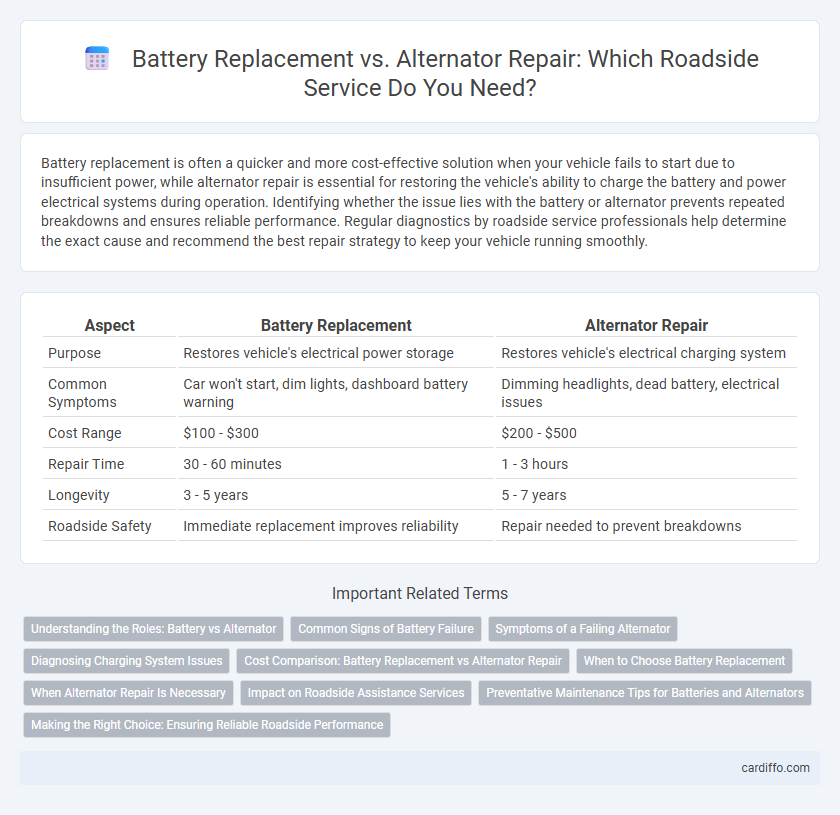Battery replacement is often a quicker and more cost-effective solution when your vehicle fails to start due to insufficient power, while alternator repair is essential for restoring the vehicle's ability to charge the battery and power electrical systems during operation. Identifying whether the issue lies with the battery or alternator prevents repeated breakdowns and ensures reliable performance. Regular diagnostics by roadside service professionals help determine the exact cause and recommend the best repair strategy to keep your vehicle running smoothly.
Table of Comparison
| Aspect | Battery Replacement | Alternator Repair |
|---|---|---|
| Purpose | Restores vehicle's electrical power storage | Restores vehicle's electrical charging system |
| Common Symptoms | Car won't start, dim lights, dashboard battery warning | Dimming headlights, dead battery, electrical issues |
| Cost Range | $100 - $300 | $200 - $500 |
| Repair Time | 30 - 60 minutes | 1 - 3 hours |
| Longevity | 3 - 5 years | 5 - 7 years |
| Roadside Safety | Immediate replacement improves reliability | Repair needed to prevent breakdowns |
Understanding the Roles: Battery vs Alternator
The battery supplies the electrical power needed to start the engine and run accessories when the vehicle is off, storing energy for ignition and initial power bursts. The alternator generates electrical power while the engine runs, recharging the battery and powering the vehicle's electrical systems continuously. Understanding these distinct roles clarifies that battery replacement addresses starting and power storage issues, whereas alternator repair resolves problems with electrical generation and charging during operation.
Common Signs of Battery Failure
Common signs of battery failure include slow engine crank, dim headlights, and electrical accessories malfunctioning. Frequent jump-starts and a swollen battery case also indicate the need for battery replacement. Recognizing these symptoms early helps determine whether battery replacement or alternator repair is necessary for roadside assistance.
Symptoms of a Failing Alternator
A failing alternator commonly causes dim or flickering headlights, dead battery warnings, and electrical malfunctions such as power windows or radio issues. Unusual noises like grinding or whining and a burning rubber smell often indicate worn alternator bearings or a slipping belt. Identifying these symptoms early can prevent unexpected vehicle breakdowns and distinguish alternator problems from simple battery replacement needs.
Diagnosing Charging System Issues
Diagnosing charging system issues involves testing both the battery and alternator to identify whether battery replacement or alternator repair is necessary. A multimeter can measure voltage output, where a healthy alternator typically produces between 13.8 to 14.4 volts with the engine running, while a failing battery may show low voltage or inability to hold charge. Professional roadside diagnostics prioritize accurate assessment of electrical components to prevent misdiagnosis and ensure reliable vehicle operation.
Cost Comparison: Battery Replacement vs Alternator Repair
Battery replacement generally costs between $50 and $200, depending on the vehicle make and battery quality, while alternator repair expenses range from $300 to $600 due to the complexity of parts and labor involved. Choosing battery replacement often offers a more affordable and quicker solution for common starting issues, whereas alternator repairs can provide long-term reliability by restoring the vehicle's charging system. Understanding these cost differences helps prioritize repairs based on budget constraints and vehicle symptoms on the roadside.
When to Choose Battery Replacement
Choose battery replacement when your vehicle experiences slow engine crank, dim headlights, or frequent jump-starts, indicating a failing battery unable to hold charge. Battery testing showing voltage below 12.4 volts or a specific gravity reading under 1.225 confirms the battery's diminished capacity. Opt for replacement if the battery is over 3-5 years old or shows physical signs of damage like corrosion or swelling, as this ensures reliable roadside performance.
When Alternator Repair Is Necessary
Alternator repair is necessary when symptoms such as dimming headlights, warning battery light on the dashboard, or frequent stalling occur, indicating the alternator is failing to charge the battery properly. A malfunctioning alternator can cause the battery to drain rapidly, making replacement insufficient and costly if not addressed promptly. Diagnosing alternator issues early during roadside emergencies ensures reliable vehicle operation and prevents complete battery failure.
Impact on Roadside Assistance Services
Battery replacement generally involves faster roadside assistance, minimizing vehicle downtime and enhancing customer satisfaction. In contrast, alternator repair is more complex, often requiring extended service time and specialized equipment. Efficient diagnosis distinguishing between battery failure and alternator issues optimizes roadside resource allocation and improves service response times.
Preventative Maintenance Tips for Batteries and Alternators
Regularly inspecting battery terminals for corrosion and ensuring alternator belts maintain proper tension are essential preventative maintenance steps. Testing battery voltage monthly and scheduling alternator output diagnostics before symptoms arise can prevent roadside failures. Replacing batteries every 3-5 years and addressing alternator wear signs early enhances vehicle reliability and reduces emergency repair costs.
Making the Right Choice: Ensuring Reliable Roadside Performance
Battery replacement delivers immediate power restoration during roadside emergencies, essential for starting the engine and powering electrical systems. Alternator repair ensures the continuous generation of electrical energy, preventing future breakdowns by maintaining battery charge and vehicle functionality. Choosing between battery replacement and alternator repair depends on diagnosing the root cause of power failure, prioritizing reliable performance through accurate assessment and timely maintenance.
Battery Replacement vs Alternator Repair Infographic

 cardiffo.com
cardiffo.com